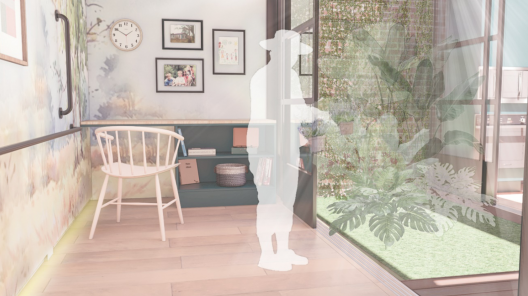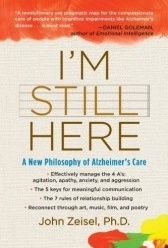“The design and layout of residences for people living with Alzheimer´s — their architecture, interior, and landscape — can augment residents' memories and their ability to function independently....”
John Zeisel (1)
Alzheimer's, one of the mental diseases that affects especially the elderly, so far has no cure and is progressive. John Zeisel offers us not only a robust academic point of view but also a delicate perspective — to professionals in the health, architecture, and urban planning fields as well as to caregivers (professionals and relatives). I´m still here is a book full of examples on how to face the daily challenges of living with and caring for, in the present, a person with memories (past), but whose interpersonal relationships are transformed every day. Zeisel is an award-winning researcher and president of the I'm still here Foundation and Hearthstone Alzheimer Care and a member of the Academy of Neuroscience for Architecture. Through his experience, he concludes that pharmacological methods are not enough to deal with this disease, but socialization and affectionate measures, including a lot of compassion, should be adopted. Environments must cater for such measures and disease complexities, with safety and comfort.
Indeed, it has been a long time ago since Zeisel (2) started to advocate the importance of architectural design in the context of the relationship between Environment and Behavior (3), as in the case of his excellent Inquiry by Design. More recently, in the last ten years, Zeisel has highlighted the relationship between aging, types of dementia, especially Alzheimer's, and how to cope effectively and attentively with the various possible consequences of the disease. He has drawn attention to the importance of designing physical environments (architecture, landscaping, urban design, interiors, furniture), as well as providing visual art, music, cinema and poetry to reduce anxious, apathetic, aggressive or agitated behaviors.
The book, in the opinion of these reviewers, is mandatory reading for all those who are engaged with people with Alzheimer's and who seek to offer them healthier environments and ambiences. It is divided into eleven chapters, throughout which the author introduces us to the essentials of the disease. It affects memories and therefore the brain but there are still several opportunities for communication, coping and daily living for the well-being of the patient and carer. Part of these chapters is very relevant for researchers and designers committed to qualifying this “well-being” from an environmental point of view, such as chapters four, five and especially chapter six “Treatment by Design”.
In chapter one, “Embracing Alzheimer's”, Zeisel explains that the disease in question has no cure and that it affects memory and also compromises cognitive ability and wayfinding (i.e. being able to come home from wherever you are or even going to the bathroom at night, inside your own home, if the lighting conditions are inadequate). Furthermore, Alzheimer’s jeopardizes even more complex tasks such as packing a suitcase for a trip, remembering what was said seconds before and so on. But at the same time, he describes, always optimistically, that other parts of the brain offer us opportunities and channels of communication that are still present, such as senses, emotions, social behaviors, artistic skills (i.e. visual arts, music) and talking about one’s past. In order to support these channels of communication, it’s necessary to provide properly designed environments. These environments are supposed to stimulate the patient by providing not only sensorial rich objects and textures, but also clearly identified routes. The latter offers clues about everyday activities that can be carried out independently.
In chapter two, “Alzheimer's Journey”, Zeisel goes on to explain how the disease occurs on a daily basis, as people affected by this disease become different, but at least in the early stages of the disease, they preserve several skills and must continue to integrate socially. Over time, awareness of the disease itself becomes less present, as well as the perception of “right” and “wrong”. Associated with these behaviors, the repetition of subjects becomes noticeable. Despite this, according to Zeisel, various memories are still present, even when the person loses the ability to express him or herself correctly. In other words, Zeisel highlights here the importance of knowing the symptoms, behaviors and side effects of the disease, including spatial disorientation. Thus, far beyond drugs, the social and physical environments become relevant.
In chapter three, “The Alzheimer's Brain”, the author recalls that the disease is associated with the progressive loss of neurons, whereas it continues a creative brain. In this scenario, he demonstrates the complexity of memory and the ability to remember during the progression of the disease, also awareness of time (hour of the day, day of the week, month, year, seasons).
In chapter four, “Art and Alzheimer's”, Zeisel recommends that people with Alzheimer's may have better well-being if they engage in artistic and cultural activities. Here the author approaches the educational programs developed in museums, that encompass interactivity and are not only observational (passive) of the visual arts. These activities can stimulate the telling of stories about the objects, the description of the contents of the works of art (paintings) and critical reflections on them. For this, museums) and exhibition environments must be prepared so that such experiences are pleasant and offered in a comfortable way.
In chapter five, “The Dramatic Arts”, Zeisel expands on the importance of the arts in the daily lives of people with Alzheimer's, including music, poetry, theater, cinema and circus, inserting numerous examples in the text.
In chapter six, “Treatment by Design”, possibly the most architect-oriented part of the book — the author reinforces the idea of promoting environments that allow mobility with independence and safety (accessibility), thereby reducing stress. At this point in the book, the environmental requirements and characteristics, especially in the case of residences, are clearly expressed: exit control, identification of walking paths, respect for privacy, requirements for shared spaces and/or collective use, gardens/landscaping and a home that considers the multiple senses, including sight, hearing, touch and smell.
In chapter seven, “Building a New Relationship” and chapter eight, “Appreciating the New Relationship,” Zeisel follows the concepts outlined in chapter six, but further explores the behaviors and understanding of Alzheimer’s. This includes the use of all the senses, challenges presented by real situations in the present and how to deal with the new friendships that are established (approaches from family photos, furniture of personal use, decorative and artistic elements) that have always characterized the home of the person with Alzheimer's.
In chapter nine, “A Two Way Street”, Zeisel describes the interdependence between the person with Alzheimer's and their caregivers, including the growing need for greater medical and caregiver care (family and/or professionals) as the disease progresses. In this chapter Zeisel lists and makes a brief analysis of the social, personal and financial aspects that must be planned in the case of this disease. He also addresses the existing support programs (USA). Finally, the researcher remembers, especially in the case of caregivers who are also family members, the need to “take care of themselves” and the limits involved in offering this care.
In the case of chapter ten, “The Gifts of Alzheimer's” recalls the significant possibilities of memory and the need to persevere with a sense of humor. In this context, the proper approach includes avoiding problematic situations and communicating effectively.
In chapter eleven, “Being in the present moment” Zeisel suggests that meditation (using the breathing modes) and mindfulness can act positively, in coming to terms with one’s past issues, together with the provision of affection and compassion.
Zeisel vigorously proposes a multidisciplinary approach to the disease in which the architectural and urban environments play central roles in the well-being of the elderly. Hence, not only architecture and urbanism designs, but also research aimed at healthy environments, can improve this long journey for people with Alzheimer's and their caregivers smoother. Mental health, especially in the post-pandemic period and considering the aging of our population, demands a comprehensive view of this topic, to be considered as a matter of public policy.
notes
1
ZEISEL, John. I´m still here. A New Philosophy of Alzheimer Care. New York, Avery/Penguin Group, 2010, p. 151.
2
ZEISEL, John. Inquiry by design. Environment/ Behavior/ Neuroscience in Architecture, Interiors, Landscape and Planning. New York, W.W.Norton, 2006.
3
ZUBE, Ervin H.; MOORE, Gary T. (eds.). Advances in Environment, Behavior and Design, vol. 3. New York, Plenum Press, 1991.
about the authors
Sheila Walbe Ornstein is an architect and urban planner, full professor at the Faculty of Architecture and Urbanism at University of Sao Paulo — FAU USP and a productivity grantee from the National Council for Scientific and Technological Development (CNPq. process n. 304131/2020–2). She is a researcher and lecturer in the fields of Post Occupancy Evaluation, Environment-Behavior Relationships, Design Process Management and Construction Technology.
Ana Judite Galbiatti Limongi França holds a Ph.D. from the Faculty of Architecture and Urbanism of the University of São Paulo in Architecture Technology. She researches Evidence-Based Design methods and techniques to assess the environmental performance of buildings in use and the relationships between the built environment and the health of its users. Presently, she is developing postdoctoral research dedicated to assessing the effects of lighting on human health.






